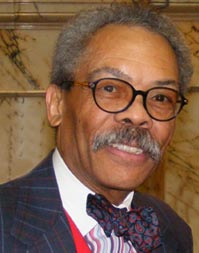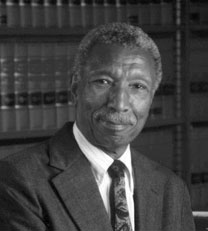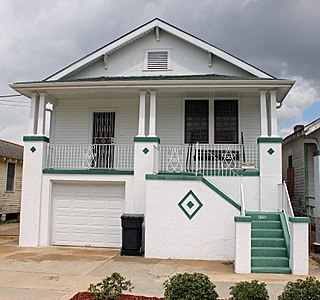Related Research Articles

Thoroughgood "Thurgood" Marshall was an American civil rights lawyer and jurist who served as an associate justice of the Supreme Court of the United States from 1967 until 1991. He was the Supreme Court's first African-American justice. Prior to his judicial service, he was an attorney who fought for civil rights, leading the NAACP Legal Defense and Educational Fund. Marshall was a prominent figure in the movement to end racial segregation in American public schools. He won 29 of the 32 civil rights cases he argued before the Supreme Court, culminating in the Court's landmark 1954 decision in Brown v. Board of Education, which rejected the separate but equal doctrine and held segregation in public education to be unconstitutional. President Lyndon B. Johnson appointed Marshall to the Supreme Court in 1967. A staunch liberal, he frequently dissented as the Court became increasingly conservative.
Brown v. Board of Education of Topeka, 347 U.S. 483 (1954), was a landmark decision of the U.S. Supreme Court ruling that U.S. state laws establishing racial segregation in public schools are unconstitutional, even if the segregated schools are otherwise equal in quality. The decision partially overruled the Court's 1896 decision, Plessy v. Ferguson, which held that racial segregation laws did not violate the U.S. Constitution as long as the facilities for each race were equal in quality, a doctrine that had come to be known as "separate but equal." The Court's unanimous decision in Brown and its related cases paved the way for integration, was a major victory of the civil rights movement, and a model for many future impact litigation cases.
Separate but equal was a legal doctrine in United States constitutional law, according to which racial segregation did not necessarily violate the Fourteenth Amendment to the United States Constitution, which nominally guaranteed "equal protection" under the law to all people. Under the doctrine, as long as the facilities provided to each race were equal, state and local governments could require that services, facilities, public accommodations, housing, medical care, education, employment, and transportation be segregated by race, which was already the case throughout the states of the former Confederacy. The phrase was derived from a Louisiana law of 1890, although the law actually used the phrase "equal but separate".

Lloyd Lionel Gaines was the plaintiff in Gaines v. Canada (1938), one of the most important early court cases in the 20th-century U.S. civil rights movement. After being denied admission to the University of Missouri School of Law because he was African American, and refusing the university's offer to pay for him to attend a neighboring state's law school that had no racial restriction, Gaines filed suit. The U.S. Supreme Court ultimately ruled in his favor, holding that the separate but equal doctrine required that Missouri either admit him or set up a separate law school for black students.
Sweatt v. Painter, 339 U.S. 629 (1950), was a U.S. Supreme Court case that successfully challenged the "separate but equal" doctrine of racial segregation established by the 1896 case Plessy v. Ferguson. The case was influential in the landmark case of Brown v. Board of Education four years later.
Charles Hamilton Houston was an American lawyer. He was the dean of Howard University Law School and NAACP first special counsel. A graduate of Amherst College and Harvard Law School, Houston played a significant role in dismantling Jim Crow laws, especially attacking segregation in schools and racial housing covenants. He earned the title "The Man Who Killed Jim Crow".
Briggs v. Elliott, 342 U.S. 350 (1952), on appeal from the U.S. District Court for the Eastern District of South Carolina, challenged school segregation in Summerton, South Carolina. It was the first of the five cases combined into Brown v. Board of Education (1954), the famous case in which the U.S. Supreme Court declared racial segregation in public schools to be unconstitutional by violating the Fourteenth Amendment's Equal Protection Clause. Following the Brown decision, the district court issued a decree that struck down the school segregation law in South Carolina as unconstitutional and required the state's schools to integrate. Harry and Eliza Briggs, Reverend Joseph A. DeLaine, and Levi Pearson were awarded Congressional Gold Medals posthumously in 2003.

The NAACP Legal Defense and Educational Fund, Inc. is an American civil rights organization and law firm based in New York City.

Robert Mack Bell is an American lawyer and jurist from Baltimore, Maryland. From 1996 to 2013, he served as Chief Judge on the Maryland Court of Appeals, now known as the Supreme Court of Maryland, the state's highest appellate court. He was the first African American to hold the position.

Robert Lee Carter was an American lawyer, civil rights activist and a United States district judge of the United States District Court for the Southern District of New York.
Browder v. Gayle, 142 F. Supp. 707 (1956), was a case heard before a three-judge panel of the United States District Court for the Middle District of Alabama on Montgomery and Alabama state bus segregation laws. The panel consisted of Middle District of Alabama Judge Frank Minis Johnson, Northern District of Alabama Judge Seybourn Harris Lynne, and Fifth Circuit Court of Appeals Judge Richard Rives. The main plaintiffs in the case were Aurelia Browder, Claudette Colvin, Susie McDonald, and Mary Louise Smith. Jeanetta Reese had originally been a plaintiff in the case, but intimidation by segregationists caused her to withdraw in February. She falsely claimed she had not agreed to the lawsuit, which led to an unsuccessful attempt to disbar Fred Gray for supposedly improperly representing her.

Mendez, et al v. Westminister [sic] School District of Orange County, et al, 64 F.Supp. 544, aff'd, 161 F.2d 774, was a 1947 federal court case that challenged Mexican remedial schools in four districts in Orange County, California. In its ruling, the United States Court of Appeals for the Ninth Circuit, in an en banc decision, held that the forced segregation of Mexican American students into separate "Mexican schools" was unconstitutional because as US District Court Judge Paul J. McCormick stated, "The evidence clearly shows that Spanish-speaking children are retarded in learning English by lack of exposure to its use because of segregation, and that commingling of the entire student body instills and develops a common cultural attitude among the school children which is imperative for the perpetuation of American institutions and ideals."
Cooper v. Aaron, 358 U.S. 1 (1958), was a landmark decision of the Supreme Court of the United States that denied the school board of Little Rock, Arkansas the right to delay racial desegregation for 30 months. On September 12, 1958, the Warren Court delivered a decision that held that the states are bound by the Court's decisions and must enforce them even if the states disagree with them, asserting the judicial supremacy established in Marbury v. Madison (1803). The decision in this case upheld the rulings in Brown v. Board of Education and Brown II that had held that the doctrine of separate but equal was unconstitutional.

Alexander Pierre "A. P." Tureaud Sr. was an African-American attorney who headed the legal team for the New Orleans chapter of the NAACP during the Civil Rights Movement. With the assistance of Thurgood Marshall and Robert Carter from the NAACP Legal Defense and Educational Fund, A. P. Tureaud filed the lawsuit that successfully ended the system of Jim Crow segregation in New Orleans. That case paved the way for integrating the first two elementary schools in the Deep South.
Donald Gaines Murray was an American attorney, the first African-American to enter the University of Maryland School of Law since 1890 as a result of winning the landmark civil rights case Murray v. Pearson in 1935.
Desegregation of the Baltimore City Public Schools took place in 1956 after the United States Supreme Court ruled, in the case of Brown v. Board of Education, that segregation in schools went against constitutional law. Desegregation of U.S. schools was part of the civil rights movement. The events that followed desegregation in Baltimore, were important to the civil rights movement across America. Recent scholarship has identified Baltimore's desegregation as an important precursor to the Greensboro sit-ins.
Bell v. Maryland, 378 U.S. 226 (1964), provided an opportunity for the Supreme Court of the United States to determine whether racial discrimination in the provision of public accommodations by a privately owned restaurant violated the Equal Protection and Due Process Clauses of the 14th Amendment to the United States Constitution. However, due to a supervening change in the state law, the Court vacated the judgment of the Maryland Court of Appeals and remanded the case to allow that court to determine whether the convictions for criminal trespass of twelve African American students should be dismissed.
June Shagaloff Alexander was an American civil rights activist.
NAACP v. Button, 371 U.S. 415 (1963), is a 6-to-3 ruling by the Supreme Court of the United States which held that the reservation of jurisdiction by a federal district court did not bar the U.S. Supreme Court from reviewing a state court's ruling, and also overturned certain laws enacted by the state of Virginia in 1956 as part of the Stanley Plan and massive resistance, as violating the First and Fourteenth Amendments to the United States Constitution. The statutes struck down by the Supreme Court had expanded the definitions of the traditional common law crimes of champerty and maintenance, as well as barratry, and had been targeted at the NAACP and its civil rights litigation.
Hocutt v. Wilson, N.C. Super. Ct. (1933) (unreported), was the first attempt to desegregate higher education in the United States. It was initiated by two African American lawyers from Durham, North Carolina, Conrad O. Pearson and Cecil McCoy, with the support of the National Association for the Advancement of Colored People (NAACP). The case was ultimately dismissed for lack of standing, but it served as a test case for challenging the "separate but equal" doctrine in education and was a precursor to Brown v. Board of Education, 347 U.S. 483 (1954).
References
- 1 2 3 "Murray v. Pearson, 169 Md. 478, 182 A. 590 (1936)". brownat50.org. Archived from the original on January 7, 2008. Retrieved February 11, 2008.
- 1 2 Rath, Molly (July 2007). "Desegregation Begins". Baltimore Magazine. 100 (7): 86.
- 1 2 Wesley, Charles H. (1981) [1929]. "The Widening Social Program". The History of Alpha Phi Alpha, A Development in College Life (14th ed.). Foundation. pp. 217–218. ASIN: B000ESQ14W.
- ↑ Text of Yick Wo v. Hopkins, 118 U.S. 356 (1886) is available from: Findlaw Justia
- ↑ Rhodes, Henry A. "The Brown Decision". Yale University . Retrieved February 11, 2008.
- ↑ "Murray v. Pearson ruled". African American Registry. Archived from the original on May 10, 2008. Retrieved February 11, 2008.
- ↑ Williams v. Zimmerman, 172 Md. 563, 192 A. 353 (1937).
- ↑ Mitchell, Juanita Jackson (2004). "Meade v. Dennistone: The NAACP's Test Case to "... Sue Jim Crow Out of Maryland with the Fourteenth Amendment". Maryland Law Review. 63. Baltimore, Maryland: University of Maryland School of Law: 773, 800–01.
- ↑ "Brown v. Board of Education, 347 U.S. 483 (1954)". findlaw.com. Retrieved February 11, 2008.
